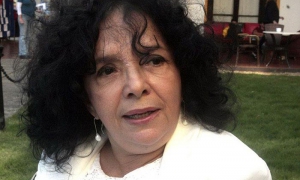"For Shakespeare, dance" are the watchwords chosen for the upcoming 24th Havana International Ballet Festival, scheduled October 28-November 7. Prima ballerina assoluta Alicia Alonso, president of the Festival, chose to celebrate the 450th anniversary of the bard’s birth with the return to the stage of several of his immortal works presented in the language of ballet. The inaugural gala will include the restaging of Shakespeare y sus máscaras, an adaptation by Alonso based on Romeo and Juliet. Thanks to a first look at the program offered to the press by the Ballet Nacional de Cuba (BNC), we know that returning to the stage will be Prologue to a tragedy, by English choreographer Brian McDonald, part of the company’s repertory since 1978; Hamlet (scenes) by Ivan Tenorio, premiered in 1982, and The Moor’s Pavane, by the Cia Opera of Nice, invited to the Festival. As is customary, complete versions of pieces from the traditional classical repertory will be presented - of special interest, La bella durmiente del bosque, (Sleeping Beauty) on the 40th anniversary of this Alicia Alonso adaptation based on the original by Marius Petipa. In 1974, Alicia staged the work in the Paris Opera, and, in 1983, her version of the classic was requested by the La Scala Theater Ballet in Milan. On the occasion of La bella durmiente del bosque’s premiere in the Paris Opera, critic Claude Baignères wrote, "The Opera’s ballet has ended the year with a masterful blow. Alicia Alonso has resuscitated this choreography, in which an undeniable rigor guarantees us authenticity." Another critic, René Sirvin, said, "We find all of the marvel and pomp promised by Charles Perroult’s story. The conception of the work by Alicia Alonso is absolutely outstanding." Likewise, Italian critic Luigi Rossi commented on the La Scala performance, "The principal feature of this choreography is its academic virtuosity, without denying its more modern language, and it has allowed the company to reach its full potential." The BNC will also regale ballet-lovers with Swan Lake and a gala dedicated to great romantic dancers, featuring the emblematic Cuban version of Giselle. Also to be enjoyed are La magia de la danza, a BNC choreography including scenes from Giselle, La bella durmiente del bosque, The Nutcracker, Coppélia, Don Quixote, Swan Lake and Sinfonía de Gottschalk. Literature is being celebrated, with the Festival additionally dedicated to the bicentenary of Cuban writer Gertrudis Gómez de Avellaneda (1814 - 1873), with a special gala performance of her work Tula, choreographed by Alicia Alonso -premiered in 1998 during the 16th Festival - with music by Juan Piñera, design by Salvador Fernández and libreto by José Ramón Neyra. This year’s performance will take place in the great hall bearing the author’s name in the National Theater of Cuba complex. The beautiful special program prepared for the premiere recalls that the ballet Tula is among the numerous theater scripts created by Avellaneda, and in the first act several characters appear who are representative of the whole of her dramatic production: Leoncia, the flowers’ daughter and Baltasar. The three contain the principal performance arts modalities cultivated by the celebrated author: drama, comedy and tragedy. In the second act are three episodes reflecting Avellaneda’s intense love life, the tragedy of truncated maternity and triumphal return to the homeland, which culminates with a tribute offered by Havana society at the Tacón Grand Theater, now the Havana Grand Theater, currently being restored. Alicia Alonso wrote for the occasion, "Gertrudis Gómez de Avellaneda, as a writer and human being, is one of the most outstanding female personalities of the 19th century, a legend shared by Cubans and Spaniards… No doubt, Tula was a woman of great talent and advanced ideas on issues which remain relevant today, such as those related to equality of opportunity for women… The valuable theater work of this writer, as yet not sufficiently known, reveals more than a few keys to her personal situation. That is why we have partially based ourselves in the environment of her artistic creation, encountering the personality of this poetess, in this ballet which we dedicate to her with affection and admiration." The Festival has always presented premieres of new works by both Cuban and international choreographers. Two have already been announced for 2014: Percusión para seis hombres y Valsette, an abbreviated version of the well-known Nuestros Valses, by Venezuelan Vicente Nebrada. The staging is by Zane Wilson and Yanis Pikieris, directors of the Nebrada Arts Initiative, a foundation devoted to the legacy of the multi-faceted dancer and choreographer. The second, Celeste, is choreographed by Annabelle López Ochoa, with music by Tchaikovsky, wardrobe by Dieuweke van Reij, and lighting by Michael Mazzola. The BNC website synopsis reports, "Celeste is a star which shines in the fragile silhouettes of three ballerinas in a dark night sky, represented by the virile figures of 10 male dancers." Also announced are the invitations made to other companies, including the Ballet de Camagüey (Cuba); the Pontus Lidberg (Sweden); the Linga from Switzerland; the San José Ballet (U.S.); the New York Ballet Hispánico; the Nice Opera Ballet; and the Ballet del Teatro Colon (Argentina). Concerts and pas de deux will be scheduled at the National Theater’s smaller Sala Covarrubias and the Teatro Mella, with the names of several dancers already announced: Maria Ricetto and Ciro Tamayo (Ballet Nacional SODRE, Uruguay); Juaquin De Luz (New York City Ballet); José Manuel Ghiso (Ballet Santiago de Chile); Paloma Herrera and Xiomara Reyes (American Ballet Theatre). Miguel Cabrera, BNC historian, commented in an informal conversation that the Festival, founded in 1960, with a biennial schedule since 1974, has hosted a total of 922 premieres and welcomed the participation of 61 countries. This is the appetizing news so far. All indications are that the 24th edition of Alicia Alonso’s Festival will present a vast number of stellar dancers, premieres and classic works in just 10 days.

HAVANA, OCTOBER 25, 2025
OFFICIAL VOICE OF THE COMMUNIST
PARTY OF CUBA CENTRAL COMMITTEE
Culture

In Cuba, I International Biennial of Political Humor
The 1st International Biennial of Political Humor will arrive in the Cuban capital on June 14 and will be held in several venues until June 28
Recommended
PRESS DIRECTORY:
PUBLICATIONS ONLINE
Juventud Rebelde | Trabajadores. | Cubadebate | AIN | Prensa Latina | Opciones | CubaSi | Cubahora | Cubaperiodistas
MAGAZINES
Bohemia | Cuba Socialista | Mujeres | Tricontinental | La Jiribilla | Alma Mater | Caimán Barbudo | Juventud Técnica | Pionero
TV & RADIO
TV Cubana | Radio Cubana | Radio Habana Cuba | Radio Progreso | Radio Rebelde | Radio Reloj | Radio Taino | Radio Musical Nacional




